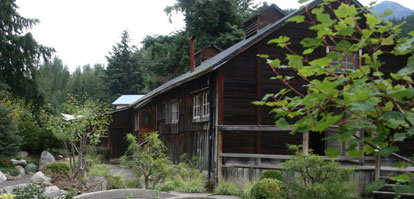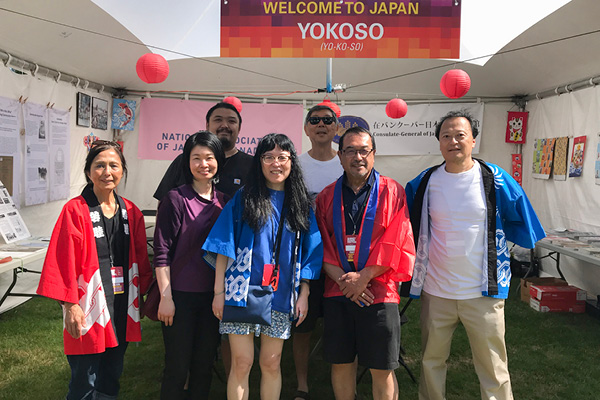New Denver needs our immediate support!
 The Kyowakai Society of New Denver originally conceived and managed the former internment camp site that was officially opened in 1994. Due to the aging membership of the Kyowakai Society and declining volunteer pool, the Village of New Denver took over the management of the site; they being the legal owners of the site. This year marks the 20th anniversary and plans are underway for celebrations to take place on Saturday, August 9th in New Denver.
The Kyowakai Society of New Denver originally conceived and managed the former internment camp site that was officially opened in 1994. Due to the aging membership of the Kyowakai Society and declining volunteer pool, the Village of New Denver took over the management of the site; they being the legal owners of the site. This year marks the 20th anniversary and plans are underway for celebrations to take place on Saturday, August 9th in New Denver.
In my President’s Message of June 2011, I wrote the following comments about the New Denver Internment Memorial Centre (NIMC):
“…..two busloads of Nikkei (a large number being Nisei), took part in the May 1987 first internment camp tour organized by Reverend David Murata. The miles that we travelled allowed the Nisei to step forward and tell their stories over the bus PA system. I recall remarking to my seatmate—a Nisei lady—that coming from Ontario devoid of majestic mountains, of the majesty of the Rockies and the dark beauty of the surrounding forests. She said that the beauty of the landscape only amplified the ugliness of what happened to our community. Many of the camps have disappeared but the most memorable was the former camp in New Denver.
“At its height, the New Denver internment camp site held 1,500 Japanese Canadians. The Kyowakai (Working Together Society) was founded in 1943 by the internees as a benevolent organization to assist the internees and to liaison with the BC Security Commission. The Orchard Camp of New Denver remained in operation until 1957 to deal with those internees who had contracted tuberculosis but the Kyowakai Society is the only wartime Japanese Canadian internment organization which is still in operation today. Volunteer members of the Society administer the five original structures still standing and from May to September, the site, known as the Nikkei Internment Memorial Centre, is open to visitors. It has been designated as a site of national historic significance. Our community must find new funding sources to ensure that this site remains an important historical benchmark of our history and a tangible evidence of racism and intolerance.
“Last month, Grace Thomson, David Jensen and Naomi Sawada visited the Centre (a round-trip journey of 18 hours by car) on behalf of the NAJC Heritage Committee to review the content and the extent of deterioration of the exhibit. The Committee is indebted to the three who volunteered their services for several days. I look forward to reading the recommendations in their planned curatorial report.”
In a follow-up report, David Jensen submitted a draft report in which he noted that the memorial centre exhibit upgrade was estimated to run in the six figures. At present, the exhibit upgrade cannot be undertaken without a substantial infusion of cash. In addition, funds are required for the daily maintenance of: the Office; the 1942 and 1957 shacks; the fire station; outhouse; Centennial Hall; the Kyowakai Hall and the Heiwa Teien Garden. Due to the shortage of funds this year, the hours of operation from May 1 to September 30th may be affected.
Grace Thomson in an email letter sent to the national executive on October 22, 2010 noted: “I believe this (NIMC) is an important project, that is, the Centre, as representing not only a tragic chapter in our history which should be communicated to all Canadians, but also as a place for remembrance, and pilgrimage…”
Growing up in Japan, I was surrounded by traditional children’s songs and nostalgic songs that harkened back to my youth. The song, Aka Tombo (Red Dragonfly) transports me back to the open field where I happily tried to catch them with a huge net made by my maternal grandfather. The song, Kojo no Tsuki (Moonlight on a Ruined Castle) evoked images of the Sengoku warring state period of the samurai and the folly of grand ambitions. Donning on our heads kabuto made from folded newspaper, we imagined to be those tragic fallen warriors. But no other traditional song tugs at heartstrings than, Furusato (My Country Home) composed by Tatsuyuki Takada with lyrics by Teiichi Okano in 1914.
I chased rabbits in the mountains
I fished for minnows in her rivers
Even now those dreams still return to me . . .
Although the context and the lyrics of the song is different, most of the Nisei generation spent an important part of their formative years in the furusato internment camps of British Columbia. Sheltered by their Issei parents from the naked racism of the time, the Nisei children explored and played in the forests and streams. Rather than allowing the internment to deprive them of their youth, they made the most of those trying times. Many Nisei have told me that they have fond memories of their childhood in the internment camps. As they grew older, they understood the full injustice of the internment and fought for redress. New Denver represents the many internment and road camps that have long disappeared. She must continue to stand as a sacred memory of those dark years but also as a testament of our community’s indomitable spirit. Perhaps the Furusato song may not be an appropriate metaphor to use to describe New Denver but it was a nostalgic home during the war years. The current financial challenges are now calling us back to her.
I appeal to the readers of The Bulletin to make a financial donation to ensure that the NIMC will continue to stand as an important benchmark in the history of Canadian civil and human rights. In closing, let me note that on my visit to New Denver in 1987 I chanced to speak with Mr. Sakaye Hashimoto who shared with me his dream of creating what is now NIMC. He subsequently became its President and is now a Board member of the Kyowakai Society. For his sake and the current and past members of the Kyowakai Society, we must not allow New Denver to close.
For further information about the anniversary or to make a donation, please contact Momoko Ito, NIMC Manager at: nimc@netidea.com



